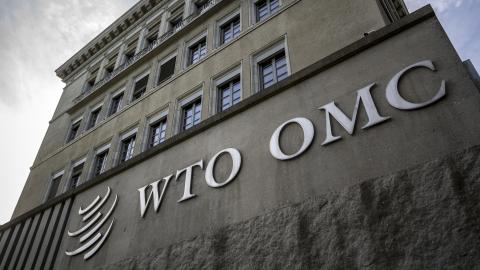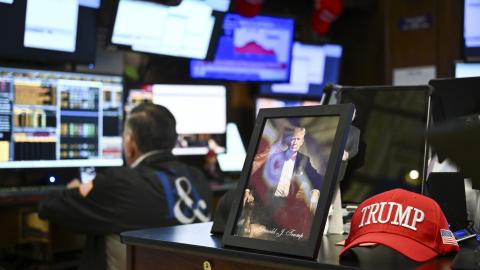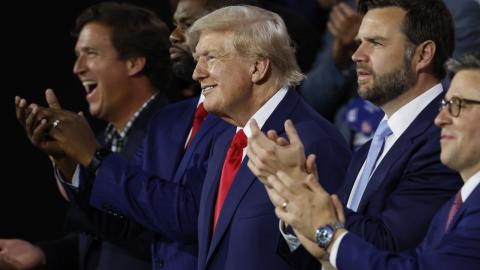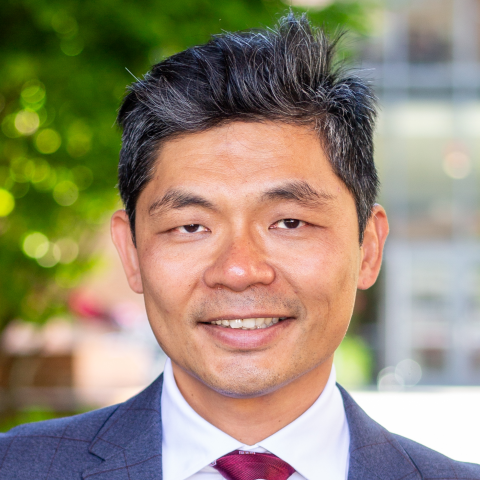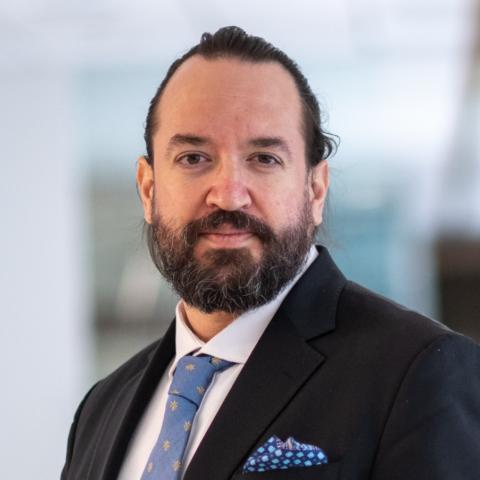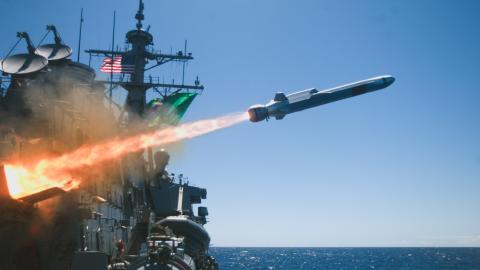
America First and the Trump Administration’s New Investment Agenda


Senior Fellow
Thomas J. Duesterberg is a senior fellow at Hudson Institute and an expert on trade, manufacturing, economics, and foreign policy.

Deputy Director, Japan Chair
William Chou is deputy director of Hudson Institute's Japan Chair.
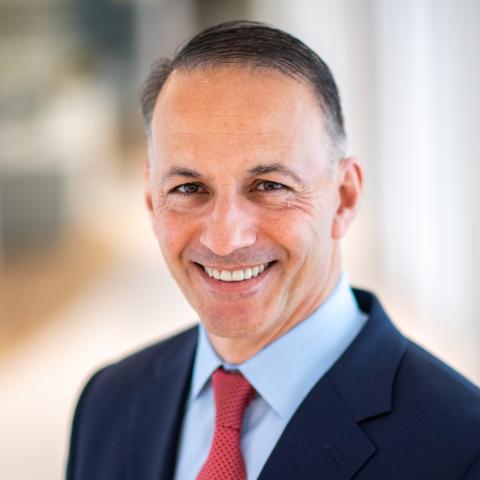
Visiting Senior Fellow
Mario Mancuso is a visiting senior fellow at Hudson Institute, where he focuses on national security, foreign policy and economic statecraft.
Join Hudson’s Mario Mancuso, William Chou, and Thomas Duesterberg for a discussion about the Trump administration’s recently announced America First Investment Policy. The event will explore the new policy through the lens of strategic competition between the United States and China, US alliance politics, and broader political economy considerations.
Episode Transcript
This transcription is automatically generated and edited lightly for accuracy. Please excuse any errors.
Mario Mancuso:
Good morning everyone and welcome to our Hudson Institute event, America First and the Trump Administration’s new investment policy. My name is Mario Mancuso. I’m a senior fellow here at Hudson and I’m really pleased to be with you today. It turns out that our timing could not be better. There was a new announcement in this area yesterday and obviously I think as many of you know, new tariffs are set to be announced later this afternoon, so I am really pleased to be with you today. I’m also especially pleased to be joined by my Hudson colleagues, Tom Duesterberg and William Chou, both of whom are also senior fellows here at Hudson. Tom focuses on manufacturing and trade and foreign policy and economics. William is the deputy director of Hudson’s Japan chair and really focuses also on regional trade innovation and other issues. So we’ve got some great guests with us today.
This is an interesting and timely and important topic and again, we’re delighted to be here. Perhaps we’ll just start by saying that this is obviously... America’s investment policy is just one piece of what appears to be a broader administration effort to address some macro challenges in the world, particularly with respect to US and China’s strategic competition. And the theory of the case seems to be that the US needs to improve its economic and obviously strategic position. And one way to do that is to enhance US manufacturing and to enhance US competitiveness. The open question of course is whether these policies will do that. We’ll talk a little bit about that today. But what I thought as we jump into the discussion, I would give some initial thoughts and obviously William and Tom would do the same and then we’d sort of have a conversation leaving some time at the end for some questions in the group.
So here’s my sort of thumbnail sketch just to start things off here. The key question I think that many are asking, “Is this new investment policy actually new?” There’s a lot that’s familiar here and I would venture to say yes, there are aspects to this that are quite new and the first thing I would point out is that the new policy explicitly equates economic security with national security and anyone who’s been following this I think in recent years will see this as well. That’s obvious. That has been the case since certainly the latter part of the Trump administration throughout the Biden administration, and we’re seeing it again in this new administration. On the other hand, when it comes to US is the US’s historic approach at regulating inbound investment. The assertion that economic security is national security is actually quite different. One can go back 50 or 60 years to CFIUS’s authorizing statutes where there’s an affirmative effort to say, “Actually, that economics has nothing to do with CFIUS, that CFIUS should be exclusively focused on national security.”
And yet, for all intents and purposes, that in practice has shifted in recent years and is most recently made explicit by the new administration. The second thing that I think is quite new is the broad view of executive power as it relates to this investment policy and the use particularly of IEEPA, a statute that is used in cases of national emergency to regulate and otherwise do policy in this space, that I think is new. Third point, the administration’s leveraging or seeking to leverage the size and attractiveness of the US market to dissuade other foreign investors from investing in China, particularly in emerging technologies in China. Fourth, the focus the administration is making on saying, we welcome passive investment including presumably from adversary countries, so long as it is truly passive. And five, the signaling that the administration is willing to be quite aggressive at broadening restrictions on outbound investment that is US investment in China, particularly as it relates to certain capabilities.
As you may know right now, restrictions, outbound restrictions are in place as of January of this year that relate to certain sectors, parts of certain sectors, AI, semiconductors, and quantum. But the new administration has signaled that’s willing to go beyond that to touch sectors like biotech and advanced manufacturing and hypersonics. So I think in a lot of meaningful ways there is something new here. This is an important policy and important development. We can talk about it a little bit more, but with that as a setup, maybe I’d like to turn it over to Tom to give your initial thoughts.
Thomas J. Duesterberg:
Okay. Thanks, Mario. I’m going to focus a little bit on China. The executive order that was issued has a pretty clear focus on China to the extent that I noted. Section 2B reads in part, “Restrictions on foreign investors access to the United States assets that is third parties will ease in proportion to their verifiable distance and independence from the predatory investment in technology acquisition practices of the PRC and other foreign adversaries or threat actors.” I’ve been looking recently at another amazing episode in Chinese economic history, which is the revival of their stock market. There have been the previous peak in the Chinese stock market was before COVID and it had a little bit of an upswing in 2015, then right after COVID. But recently, and partly in response to the announcement by DeepSeek, their AI competitor, there’s been this amazing turnaround in the Chinese stock market and that has had an impact on the US market, which is perhaps a little overextended, but in the first, between January one of this year and March 17th, I think our data comes from, the five leading technology companies in China have grown as follows.
Tencent up almost 30 percent, Alibaba up 70 percent, Xiaomi up 66 percent, BYD up 52 percent and Meituan up 16 percent. Whereas the top five US technology leaders have all dropped, Apple 15, Microsoft 9, Nvidia 14, Alphabet 17 and Amazon 13. This all started or was given rocket fuel by the DeepSeek announcement, and then Xi met with Jack Ma and some other tech leaders in an apparent revival of their status in China. Anyway, it gave impetus to a stock market revival, but I think if we focus on this, the real causes of this, it’s a weak base that they’re building on, and I think that understanding how they achieved this revival will suggest some leverage that we have in the United States for over the weak Chinese economy and especially over the role of US investment in China.
So I don’t think we need to dwell on the technology aspects of the DeepSeek announcement. Anyone who thinks that they spent $6 million to build a world-class AI system, it doesn’t have a firm grip on reality, let’s put it that way. And there’s been evidence of how they have exploited, for instance, the ability to work at Microsoft and other American labs in China and glean information, let’s put it nicely.
Their entire tech sector is borrowing information and technology from the United States for their AI implementation. But what is perhaps lesser known, but equally important is that she’s efforts to funnel state and public money, partly through the stock markets or VC investment and direct investment estimate depend a lot on Western money. The Chinese stock market literally came back from the dead, and I gave you a few statistics on that. The Hang Seng market this year is up about 17 percent, which is interesting and I’ll return to that. Xi has deployed some regulatory power within China to stimulate the stock market and to pump up the returns. He has authorized the banks to issue loans to stockbrokers and institutional buyers collateralized by those stocks themselves. He has funneled money from the trade surplus in China directly into the state banks to pump up the money supply and enable more loans going into the economy, especially the high-tech economy.
More recently, The People’s Bank of China announced that they were going to shift their monetary policy from prudent, quote, unquote, prudent to a reasonable easing. So that too is pumping money into the stock market. He’s also funneled one third of Chinese foreign reserves into managers in Hong Kong, which is the epicenter of the rise in the stock market, especially the technology stock market in China. So US money, I think we should note, is also providing, I wouldn’t say rocket fuel, but is helping, let’s put it in a neutral term, helping this rise in the stock market, which is in turn undermined the technology stock market here in this country. US money is going directly into China’s shares through listing in New York and Hong Kong. 286 Chinese companies are now listed on US exchanges with a total of over $1 trillion in market capitalization, which is up 250 billion from early 2024.
Since January ‘24, 48, new Chinese IPOs were listed in the United States. This has helped JD, well, US institutions own 36 percent of td.com, 28 percent of Baidu, and I think about 20 percent of Alibaba. So the investing in America first policies, I think has the ability to limit the amount of money going into the stock exchanges, which are helping out the technology sector in China. There are ample reasons I think, to do this. I think we ought to be thinking about delisting Chinese shares that are listed on our markets, partly because of their failure to adhere to our accounting standards. There’s been some fraud in some of the Chinese listings and now this is all going to be reinforced by the new emphasis on linking national security to high technology firms. So we have also no reciprocity with the ability of our technology firms to operate in China, they’re basically barred from that market. So if we’re going to have a reciprocal trade policy, I guess we’ll hear something this afternoon about that. That’s another reason we can use the new tools from the executive order.
And generally, I think we need to also look at both portfolio investment, i.e., stocks and direct investment, VC investment for the ability to limit US and Western, hopefully, convincing our allies to go along with us. And I think this would have a major impact on both the Chinese stock market, but the real economy in China, which is teetering on the edge of low growth. They simply don’t have enough financial power. Their markets are shallow, but they’re also over leveraged at the government level. So US Western money going into China gives us, I think, an advantage to having a major impact on their high-tech economy. So let me stop there. Shortly.
William Chou:
Great. So thanks to all of you for coming today, and I’d like to talk a little bit about the role of allies in this America First Investment Policy. So obviously look, I think we’re all really focused on the tariffs announcements that are going to be made later this afternoon, but I think the ultimate goal of the Trump administration is to revitalize American industry. Both Secretary of Commerce Lutnick and USTR Greer in their Senate testimony talked about the need to turn the United States into a nation of producers. And so I think what hasn’t been discussed so far in terms of talking about the administration’s economic policies has really been about investment, and I’m really glad that we’re talking about this today.
And it’s important, it’s very evident in terms of the America First Investment Policy executive order, which clearly lays out the administration’s focus on investment economic security as interlinked, as these interlinked elements of achieving the aim of rebuilding American industrial strength. And related to this is also the recently announced United States Investment Accelerator Office within the Department of Commerce which will facilitate and expedite investments above $1 billion that helps investors navigate the US government’s regulatory processes, as well as reduce regulatory burdens and basically help them increase in access and use of American resources.
And so the focus on investment economic security creates opportunities and shared alignments with close allies who understand the importance of effective regulatory environments for economics and production as well as secure supply chains. And in the case of Japan, which is really my specialty, Prime Minister Ishiba during his visit back in February announced how Japan will increase its investment in the United States to $1 trillion up from $800 billion right now.
So I think there are three main areas of potential US-ally cooperation in terms of investment in the United States. One is manufacturing. The United States is the top FDI recipient in the world with close allies like Japan, the UK, and the Netherlands, leading the way. Moreover, I think investment is concentrating in manufacturing. I think about 42 percent of foreign investment in the United States is focused on manufacturing. And so it’s clear that manufacturing will be a priority going forward in terms of ally investments in the United States, and that includes areas like shipbuilding, automobiles, and semiconductors. And there’s already a past precedence of this. So for instance, the announcement by Hanwha to buy the Philadelphia shipyard back in last summer, which President Trump raised unilaterally on his part in his discussion with President Yoon during a phone call back in November, as well as obviously Japanese automakers of four plus decades of history investing in production and jobs and communities in the United States. And finally obviously more recent investments by semiconductor companies such as Samsung and SK Hynix in semiconductor production in the United States.
So I think there’s already precedence for this, and I think the recent announcement by Hyundai to build automobiles as well as steel in the United States, I think that is a positive trend about demonstrating how this is likely to go forward.
Another area of cooperation is energy. So energy is obviously a clear priority of the administration with their first day one announcement of the Unleashing American Energy Executive Order. It embraces all sorts of energy and will deregulate exploration and production thereof in the United States. And energy security is obviously a real key priority for American allies. Geopolitical instability in recent years has demonstrated that energy security has to be factored into the negotiation of energy contracts abroad.
And so with the current administration, much of the recent focus has been on LNG liquefied natural gas, especially Alaskan liquefied natural gas. And Prime Minister Ishiba set the tone by promising to buy more US LNG, which is especially timely for Japan, given that its long-term contracts on LNG are set to run out in 2029, which creates opportunities such as the Alaskan LNG project, which is slated to come online around 2030 or 2031.
And so while the United States is happy to supply energy to allies, investments in upstream and midstream processes from allies are also very compelling and welcome. And this is especially important given that US allies such as Japan and South Korea dominate much of sort of the export/import shipping and power generation aspects of this larger ecosystem, which makes it a win-win opportunity, especially in developing markets in Southeast Asia, like we talked about in a conference we had on Southeast Asia two months ago.
And the final area I think of cooperation is in economic security. So key provisions within the executive order, which I think Tom has mentioned earlier, limits inbound investment from and also outbound investment to the PRC and key strategic sectors. And this really highlights how much investment in economic security and national security are interlinked in the eyes of this administration.
So one area I think of focus is really R and D. So we talked about China's developments in DeepSeek and AI, and I think regardless of what we do in terms of export controls, whether it's a high fence, big yard, or a smaller fence, smaller yard, I think China will continue to push ahead in these key strategic sectors.
So I think the priority then is to focus on running faster than our competitors to focus more on R and D and oftentimes in collaboration with our key allies. And this includes cooperation areas such as AI and semiconductors. So obviously Masayoshi Son, the owner of the head of SoftBank, obviously made a lot of waves in terms of his $100 billion pledge in AI in the United States, including $20 billion in Stargate. The new Office of the Investment Accelerator will also facilitate and accelerate such investments, helping them to navigate the challenging processes of American regulatory sort of a framework. Some of this work also goes to Senator Hagerty who led the way in sort of adding key technologies to the FAST-41 of expediting federal permitting process.
And so all of this creates an ecosystem that allows for US-ally cooperation in these key strategic sectors. So examples include the Rapidus-IBM collaboration for semiconductor production in Japan, but R and D back in the United States, as well as other companies like Tokyo Electron's R and D work in the United States that seek to build out a wider ecosystem of semiconductors and essentially greater economic resilience.
And then related to that is also supply chains and I think COVID and the PRC cutoffs of critical minerals in the past decade plus demonstrate that the supply chain security is both an economic and a national security issue. Japan obviously led the way in its support of, in this building out its supply chain resilience through its collaboration with Lynas, the Australian Mining Company over rare earths back in the 2010s, cutting Japanese dependency on PRC supplies from 90 to 60 percent. However, the PRC still controls three major minerals, the three Gs, the germanium, graphite, and gallium, which are important for existing manufacturing initiatives, as well as next generation technologies like solid-state batteries and so on.
And so I think with the new executive order and also the recent executive order to increase US critical minerals production and processing provides opportunities for allied investments in both production as well as processing in the United States providing secure access to minerals needed for competitive economies in the face of unfair players in the marketplace. And I think with that, I'm just going to kick it over and go to Q and A.
Mario Mancuso:
Thank you. I have some follow-up questions for each of you. So one of the key insights of the administration’s new policy is that it’s not just focusing on the outbound side of the equation, it’s not just that US capital contributes to certain Chinese capabilities, that’s obviously the case, but that US managerial expertise, subject matter expertise, the credibility of certain US investors, the network reach that US investors have, all of these things together in a sense are ingredients for Chinese success. And what the policy makes clear is that the government should be focused on all of those things and how they might contribute to certain Chinese capabilities that are inconsistent with US national security interests.
Tom, I want to go back to something that you said earlier. You alluded to certain ways in which the Chinese benefit from the United States, Chinese technology industry benefits from the United States. Can you expand upon certain things that you think the US might do to reduce the ways in which US investors or US markets generally are facilitating the growth of Chinese technology in particular?
Thomas J. Duesterberg:
Well, in the high technology area, I mean, let’s face it, US firms have been very active with their own research labs in China. And let’s face it, they benefit from that. There’s a lot of skilled engineers in China, and a lot of Chinese students come here to the United States, some of them stay on and work in our high-tech companies and they’re paid by the Chinese to bring technology back. And there’ve been any number of cases that have worked away through the courts about Chinese workers who, exfiltrated is one term of art that’s been used, technology... In the case of DeepSeek, they are accused of exfiltrating what they learned working at American AI firms and the data that those firms have used. And so that’s cutting off those sorts of interactions in our high-tech areas that have been identified in this executive order as critical to us. So it includes limiting access to working in our companies in those areas, having an eagle eye for students that have studied here and perhaps done internships or worked for a few years, paying close attention to what they are bringing back.
So there’s also the area of VC investments into China, which a lot of our firms have been doing for the last 15 or 20 years in some of the key Chinese competitors to our high technology industries. We have to have more transparency, I think, into those investments and in the areas that have been designated in this executive order and other places as critical to our high-tech leadership and our national security, our defense sector. We have to be more both aware of that and willing to intervene to prevent outward bound investment via VCs, via direct investments into Chinese firms that are competing with us in those areas.
Mario Mancuso:
Thank you. William, question for you, and this is really an open-ended question. The policy makes pretty clear, and I think, Tom, it was you who read the portion of the policy that says that the US government’s review of inbound investment will essentially be calibrated based on the distance that the foreign investors has to China. In other words, the closer the foreign investor is to China, the more skeptical US regulators will be with respect to foreign investment. On the other hand, the policy also says that, “We want to encourage passive investment in the United States, especially from our allies.” The challenge that globalization has presented... I mean globalization has had in many ways many, many benefits, but it also presents certain challenges in the current moment we’re in, which is that, for example, many US allies in Europe have significant exposure to China.
And so to assert the principle that we want to both increase foreign investment from allied countries and be more skeptical of Chinese investment, that’s hard to square sometimes when some of our closest allies have very significant exposure to China. Any thoughts on that generally? And again, William, this is for all of us to consider, but that strikes me as a hard... I agree with the goal. I think it’s going to be very hard to operationalize in many cases when you have, for example, pick a European company, leading technology company that is benign in every respect, domiciled in a close US partner, but may have more than 50 percent of its revenues that they derive from China. How should we think about a foreign investor like that?
William Chou:
Yeah, I mean I think that that creates unique challenges and frankly a series of hard choices for companies from allied countries. I guess what I would say is I think the question is really, “Do you want to be in the China business long term? Is this the sort of market and environment in which you want to operate in?” I do think that especially with I think less strategically valuable sectors, I mean some exposure is inevitable. We have you McDonald’s, we have Pepsi in China. I think that’s rather inevitable. But I do think that in terms of the key strategically important sectors, there has to be some real discussion about long-term, where do we want to operate in? Is it going to be in the market with lots of lack of transparency, with arbitrary espionage laws that can grab executives off the street and basically keep them in perpetuity as potential espionage agents, ways of sort of essentially accusing them of...?
For instance, if you try to look into your supply chains to comply with the Uyghur Force Labor Protection Act, that this is somehow espionage and therefore, it gives us the power to arrest you. And so I think it is a key balance. I think long-term the United States’ large size, it’s a compelling sort of market and potential growth and sort of clear regulatory system. And hopefully with these new EOs that sort of facilitate new entrants into the market from allied countries, I hope that creates new opportunities. And to be perfectly honest, I think the argument has also been made that economic security, the need to secure our supply chains creates new economic opportunities as well. So as you theoretically possibly consider moving some of your supply chains from China to the United States or back home, this also creates a knock-on effect of invigorating your own economies as well. And so I think that’s a hard decision to make for a lot of these companies, but I think they have to sort of adopt a bigger picture and long-term perspective about, “Is this where we really want to make our bets on long-term?”
Mario Mancuso:
Just related to that, and this is... Maybe we’ll do one final question amongst us and then we’ll open it up to the audience here. Again, I think the policy is a very strong start by the Trump administration. I think especially both sides of the equation trying to increase passive or otherwise benign investment in the United States and limit US investment in at least those industries in China that may have negative policy externalities to the United States. What’s fascinating is you read this, what I think comes straight out is the role of some of the sovereign wealth funds, for example, in the Middle East that are close US partners and allies. Think for example, Saudi Arabia or the United Arab Emirates. These are pools of sovereign capital that could actually play a very important role for this administration, particularly under the Investment Accelerator program that was announced yesterday. So any reactions to that?
But that’s an obvious... When you think of what the administration is trying to accomplish, you suddenly have... The pools of global liquidity are either largely in China or in terms of sovereign liquidity, I’m not talking private sector, but either in China or they’re in the Middle East. And so it strikes me this is a very unique opportunity for the administration to both encourage foreign investment from, let’s call it, Middle Eastern sovereigns in ways that are consistent with US national security and to simultaneously dissuade them from investing into Chinese emerging technologies. Any thoughts on that?
Thomas J. Duesterberg:
I don’t have a good window into Middle East and how they invest. You have sovereign wealth funds in Europe, I mean notably Norway.
Mario Mancuso:
The Dutch, yeah. Pension funds.
Thomas J. Duesterberg:
Yeah, the pension funds all over the place, including the United States and the executive order touches on investments of pensions fund, university endowments, and the like. Let me, if I may backtrack a little bit and think about what investing in China really means in terms of direct investment, say the manufacturing and the technology sector. We went through this period after Deng Xiaoping where the promise of the Chinese market, both in terms of the consumer market, but collaboration with industry, we all thought that was going to end up in a good place. They would be more or less compliant with their obligations that they undertook when they joined the World Trade Organization.
But I think what we discovered pretty quickly was that it’s a mercantilist society. They have no intention of operating in the system that was set up after the Second World War and which benefited them, but it also benefited the west. So their typical modus operandi is to encourage investment into China. They did it in, let’s say, high-speed rail and autos. They invited US, European, Japanese companies to come in. They acquired the technology, they lowered the price of production because they are able to do that. And so in industry after industry, we have the Chinese acquiring the technology either by observation or by other means, then becoming a competitor in the global market and lowering the price, driving out the competition.
I mean you can see that more recently in the green technologies, solar, wind, EVs now. And that’s why one has to make a choice. In the auto sector, the Europeans made a big choice. I mean we did too of operating in China. I was running a trade association back in the ‘90s, in the first decade of the 21st century and talked to a lot of auto guys who were investing in China. One of them came to me one day and said, “I have this offer from a Chinese firm to build a bunch of important parts for a car that was being produced in China.” And he said, “It’s exactly the same plans that I got from Volkswagen who I’m building for.” So there was that sort of thing that was going on, but the general point is that that’s their modus operandi and it’s not going to change. So you have to make a choice of risking your crown jewels.
I mean, I go back to the high-speed rail systems that the Europeans and the Japanese excelled at. So we don’t want to do that in semiconductors or artificial intelligence or quantum computing. And that’s a reason that we ourselves ought to be very wary of investing in China. And we ought to try to do what we can to bring our allies along. The elephant in the room here today is that we’re going to impose tariffs on some of our best friends and we’ve been asking them to make a choice to either be helpful to us on what we do with China or not. And it doesn’t help that we put a cost on them for doing business with us. William specified a bunch of ways that we can work together. We ought to be doing that instead of simply relying on tariffs to try to rebuild our industrial infrastructure in the United States. Sorry, for getting off-topic.
William Chou:
Yeah, yeah, I mean, I’ll just add a few comments to this. First of all, I am also not a Middle East guy. I kind of made that decision about 20 years ago when I decided to focus on Japan instead of the Middle East in grad school. That said, though I think it is notable that the president’s first foreign state visit will be to Saudi Arabia. I don’t think that’s entirely a coincidence. In addition to that, I think I agree with a lot of what Tom said in terms of China’s sort of mercantilist policies and its efforts to sort of both acquire foreign IP and technologies and sort of insinuate themselves into foreign markets and eventually dominate them. This is something that they’ve done in a lot of different sectors, including green technologies and automobiles.
And I think what this executive order creates the opportunity for is essentially allows the Middle East countries, these sovereign wealth funds to diversify their holdings. The question is, “Do you want to be utterly reliant on both access to the Chinese market through say energy exports and also sort of rely on Chinese imports into your own markets or do you want to diversify your holdings by investing in the United States in these other sectors that are possibly promising for their own efforts to sort of move up the value chain, be it say an AI or other sectors?” And so I think that’s the compelling part about this EO.
In addition, to be perfectly honest, I think Middle Eastern countries and their sovereign wealth funds don’t really have extensive investments in the United States. And so I think a lot of the challenge for them really is that if they are willing to diversify their holdings, there is the challenge of actually, “How do you navigate the US regulatory environment, especially when there’s so little tacit knowledge back home?” And so I think in terms of the office Investment Accelerator office in DC, I think that creates a platform by which we can actually facilitate these investments from these sovereign wealth funds.
Mario Mancuso:
Just on that point... And we’ll turn over questions. The Middle Eastern sovereigns are in the United States in pretty passive ways today. And I think what the accelerator proposes to do is to enable the large investors because the accelerator is aimed itself at $1 billion plus investments. I mean, that’s not an everyday sort of investment, right? To be more active in the United States. So I think we will see more sovereign investment from the Middle East. I think the investment accelerator will be central to that. Some of our closest friends like the Emiratis and the Saudis, our closest security partners and among the closest security partners in the world. And they are in effect the swing states of global liquidity. So the US is competing for that capital with China in many ways. So with that, maybe we’ll just take some questions from the audience. I know we’ve kind of meandered. Please. If you can just announce your name.
Erin France:
Sure. My name is Erin France.
Mario Mancuso:
Okay.
Erin France:
[inaudible 00:42:52] International. Thank you so much. And my question specifically is for William, if we can take the next step from an answer to the previous question you gave about squaring that challenge between allies to the US that have a significant footprint in China looking to increase investment here. And we can maybe specifically use the case of Japanese companies to answer the hypothetical questions you put out. Like, “Oh, is this really the market you want to be in China?” And so on and so forth. If a Japanese company, for example, were to say, “Yes, this is still the market I want to be in, the profits are still coming.”
If you look into your crystal ball, how would you anticipate this administration responding to something like that where it does not succeed in sort of swaying allied nation companies out of China? And I’m not talking about mitigation agreements for a CFIUS case or something, but more like would you see penalties, sanctions, something down the line coming if again the administration doesn’t successfully persuade? And I’m talking more again, Japanese over European companies because I think they’re in two different categories right now in terms of the administrations we have.
William Chou:
Sure. I mean, I think it’s a little hard to do my crystal ball for the administration, because otherwise I wouldn’t be sitting here, right? But that said, I do think that, I think it’s really more that... I mean, you’ll probably see it in the CFIUS process where it might be a more rigorous investigation process to see the extent of one’s obligations to overseas markets that are problematic.
Again, I think there is a key difference between key strategic sectors as well as more retail type obligations. And so I think that would be sort of the key measurement. And I think ultimately, I think that this administration has demonstrated that it is extremely pro-foreign investment, domestic investment as well as foreign investment. And I think it’s one of those things where the more that we can welcome investments from our allies, the more we can build these stronger bonds. I think that’s ultimately the goal because I think there is this understanding that there needs to be these internal ties of economic resilience going forward.
Mario Mancuso:
Barry, if I can layer onto what William said, just a comment. What’s interesting there is language in the policy. I mean, your question’s a good one. It’s also an important one because there’s language in the policy that says the US risk appetite is changing. So historically the US has relied on mitigation agreements in close cases, but now what it’s effectively saying with respect to Chinese investment is that we’re not really going to rely on them as much. It’s either going to be up or down, yay or nay, and so the trade-off is much more acute. Riley, you had a question?
Riley Walters:
Good morning. Riley Walters, Hudson Institute. From your comments, it really seems like this administration is trying to deliver a message that America is open for business, that this is the place to invest, that this is where the future of our economic growth, the world’s economic growth is really centered in. So we have already seen huge announcements from multinational companies. I’m expecting there to be more over the next several months, maybe even years. And so what this means is we’re going to see more passive investment. We’re going to see more direct investment into new factories or restarting old factories. We’re also going to see a good portion of that in the mergers and acquisitions. And so we’ve already had a couple announcements where companies like SoftBank want to acquire US AI company.
We have the new news this week of UMC thinking about purchasing Global Foundries, which is essentially owned by UAE’s Sovereign Wealth Fund. And so I wonder, given the fact that we’re going to see all this new investment, we’re also going to have this accelerator potentially even a smaller federal workforce, on the regulatory side, what kind of message, I guess what kind of certainty should companies take away from all these developments? I know these are all very new policies. The accelerator office isn’t even going to be an office until the end of this month, and that’ll be specifically located within the commerce department. What sort of authority, I guess, what kind of leadership will that have over the entire CFIUS body, which is multi-agency?
Mario Mancuso:
Thank you. I’ll take a crack at that. I think the question of how durable some of these policy changes are is a real one because obviously this is President Trump’s second term. And the question will be how long beyond and the Trump presidency will end and how long will these policy initiatives last beyond that? I think there’s a related point, which is right now, I mean, the investment accelerator was announced yesterday. It is literally a two-page document. The investment policy was announced on February 21st. I think the conceptual design and direction is absolutely clear, but implementation matters and we don’t know what that’s going to look like, although we’re certain that the administration’s going to exercise efforts to implement it, but it hasn’t really been implemented yet. But I do think if they do that, it will have pretty significant changes for business.
Even the simple example of saying, “We will not use mitigation agreements as often when it comes to China.” It may not be the answer that in principle most businesses want to hear, but I do think for practitioners of cross-border investment, they will at least welcome the clarity of the rule. So part of the challenge to investment in the United States was in closer cases, there was always a judgment. Would this go through? Would it not? If it went through, what kinds of conditions would the US government poses? So more clarity, I think as a general matter is better the environment, for the business professionals engaging these transactions. And therefore I think for the United States, if the goal is to try to attract investment. That’s my take.
William Chou:
I’ll just quickly chime in with, sort of to second a lot of what Mario said. I think a lot of it is just frankly, the administration needs time to shake a lot of these things out. Certainly the EOs were announced very recently, frankly, other than the first two or three levels at commerce, that still hasn’t been filled out yet. So I think a lot of this will gain greater clarity as the personnel get into place in these executive agencies and departments. That said, I do think that there are some larger trajectories in terms of prioritizing American investment long-term and trying to partner up with allies and gain foreign investment for these initiatives. And I really don’t see that going away regardless of future administrations.
Mario Mancuso:
Oh, go here.
Kazo Uwaki:
Hi. Thank you. Kazo Uwaki from the George Washington University Graduate School. I have a specific question maybe directed to Wilson regarding our investment. So my impression is that there’s a less discussions about the collaborating outbound investment restrictions between US and some allies, particularly like Japan. There is more discussions ongoing about expo control and compared to that, I recognize less discussions.
So given that, I want to ask, do you recognize any [inaudible 00:51:03] perceptions about the necessity of the outbound investment restrictions from these countries like Japan and United States? If you have any takeaways from the visit to Japan, conversation with Japanese governmental [inaudible 00:51:14] and private companies [inaudible 00:51:16], I want to ask your specific views regarding Japan on this issue. Thank you.
William Chou:
Sure. Yeah, I mean, I think outbound investment is an area where I think we’re increasingly doing focus more on. I think the last administration really did focus primarily on export control until fairly late in the administration when it shifted a little more to outbound investment. I would just say that I think this administration has a holistic view of our interconnection between investment as well as economic security, and I expect that these conversations will probably be high priorities going forward. I know that there’s already working groups within Commerce, Treasury, and METI and MOF, and I assume that as we go forward, especially as they start holding the economic two plus twos, I think a lot of these things will be announced going forward.
Kazo Uwaki:
Thank you.
Ann Vroom:
Hi, my name’s Ann Vroom. I think you sort of may have addressed my question a little bit. I was wondering specifically with regard to the interface with the new accelerator, with whomever the nominee may be for deputy secretary of the Treasury for International Affairs. How do you see that working? I don’t even know who that nominee is actually right now. And how important might that role be? Thank you.
Mario Mancuso:
Right now, the announcement from the White House yesterday about the accelerator said that the accelerator will be lodged within the Commerce Department. So I assume that will largely play itself out inside the Commerce Department, although I’m sure there’ll be some inter-agency interaction, but it’s absolutely unclear. Those are some of the key details that we don’t know yet, and we wouldn’t know. The policy just announces the general direction, of course. So thank you.
Any other questions? Well, with that, I think we’re done. I want to thank you all for coming. I want to thank Tom and William for joining me today. It was terrific to spend some time with you. Thank you.

Major General Mark Mitchum will discuss the Air Force’s nascent Integrated Capabilities Command.


Join Hudson Institute for an event with Norwegian Finance Minister Jens Stoltenberg.


Join Hudson for a conversation between Indian Finance Secretary Ajay Seth and Distinguished Fellow Walter Russell Mead.
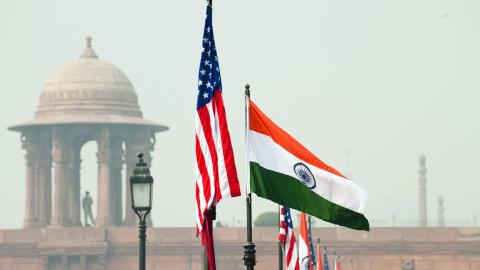

Hudson Institute’s Center on Europe and Eurasia will host its third Central and Eastern Europe (CEE) Strategy Summit.




